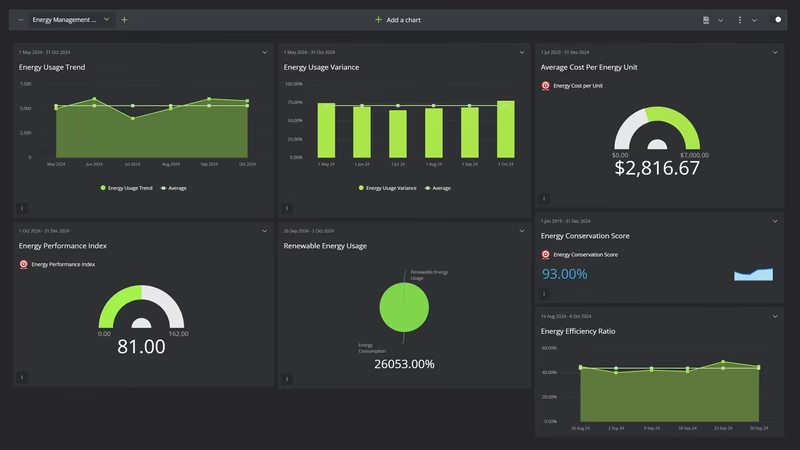Why Use an Energy Management Dashboard?
Energy management dashboards are powerful tools for organizations that want to take control of their energy usage and drive meaningful improvements. By tracking energy consumption and efficiency metrics, businesses can identify inefficiencies, optimize usage, and make cost-effective decisions. This leads to significant reductions in energy costs, improved operational efficiency, and a clearer understanding of how energy is being used across the organization.
These dashboards are particularly beneficial for companies looking to enhance their sustainability efforts. They offer valuable insights into renewable energy use and carbon emissions, helping organizations align their energy strategies with environmental goals. By understanding energy trends and pinpointing areas where waste occurs, organizations can make informed decisions that not only reduce their carbon footprint but also improve overall energy efficiency.
Moreover, an energy management dashboard fosters better long-term planning. It provides a real-time overview of energy metrics, allowing decision-makers to implement effective energy-saving strategies, monitor the success of conservation efforts, and adjust operations as needed. In a world increasingly focused on sustainability and cost management, an energy dashboard is a critical tool for achieving both financial and environmental goals.
Who Would Use an Energy Management Dashboard?
An energy management dashboard is used by a wide range of professionals and organizations. Facilities managers and energy consultants are among the primary users, as they are directly responsible for optimizing energy usage and ensuring operational efficiency. Sustainability officers and environmental compliance teams also rely on these dashboards to track renewable energy adoption, monitor carbon emissions, and measure progress toward sustainability targets.
In manufacturing, data centers, and other energy-intensive industries, the dashboard is a valuable resource for operations managers who need to minimize energy costs while maintaining high levels of production. Similarly, in the public sector, energy management tools are used by government agencies and educational institutions to manage energy consumption across large facilities, reduce costs, and meet environmental mandates.
Additionally, executive teams and financial planners use energy dashboards to monitor the financial impact of energy strategies, ensure budgets are aligned with energy-saving goals, and report on sustainability initiatives to stakeholders or regulatory bodies.
What Environmental Issues Is This Dashboard Aiming to Resolve?
The energy management dashboard addresses several key environmental challenges that organizations face today. One of the most pressing issues is carbon emissions. By tracking energy consumption and the use of renewable energy sources, the dashboard helps businesses reduce their reliance on fossil fuels, directly contributing to lower greenhouse gas emissions. This is crucial in the fight against climate change, as the reduction of CO₂ and other harmful emissions is a primary objective for many organizations.
Another significant issue this dashboard helps resolve is energy inefficiency. Many organizations waste energy due to outdated processes, poor management, or a lack of real-time data. The dashboard provides clear insights into how energy is used, allowing businesses to optimize their operations, reduce waste, and increase energy efficiency. This not only saves costs but also reduces the environmental strain caused by excessive energy use.
The dashboard also supports renewable energy adoption by tracking the proportion of energy sourced from renewable options such as wind, solar, and hydroelectric power. By monitoring this data, businesses can measure the success of their renewable energy initiatives and increase their commitment to using sustainable energy sources, which are essential for reducing the overall environmental impact of energy consumption.
Lastly, the dashboard aids in addressing energy conservation and sustainability. With KPIs that measure the effectiveness of energy-saving initiatives and conservation efforts, the dashboard enables organizations to actively reduce their energy consumption over time, contributing to a more sustainable future.
Implementing Energy KPIs with SimpleKPI
SimpleKPI offers an easy-to-use platform for creating and visualizing energy management dashboards. With customizable reports, real-time tracking, and intuitive visuals, SimpleKPI helps businesses of all sizes make smarter energy management decisions.
